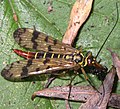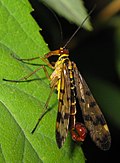m (56 revisions from w:Mecoptera) |
|||
| (5 intermediate revisions by the same user not shown) | |||
| Line 1: | Line 1: | ||
{{Taxobox | {{Taxobox | ||
| − | |||
| image = Bittacidae_fg1.jpg | | image = Bittacidae_fg1.jpg | ||
| image_width = 250px | | image_width = 250px | ||
| Line 14: | Line 13: | ||
| subdivision_ranks = Families | | subdivision_ranks = Families | ||
| subdivision = | | subdivision = | ||
| − | * [[ | + | * [[Apteropanorpidae]] |
| + | * [[Bittacidae]] (hangingflies) | ||
* [[Boreidae]] (snow scorpionflies) | * [[Boreidae]] (snow scorpionflies) | ||
| + | * [[Choristidae]] | ||
| + | * †[[Dinopanorpidae]] | ||
| + | * [[Eomeropidae]] | ||
* [[Meropeidae]] (earwigflies) | * [[Meropeidae]] (earwigflies) | ||
| − | * [[ | + | * [[Nannochoristidae]] |
| − | * [[ | + | * [[Panorpidae]] (common scorpionflies) |
| − | |||
* [[Panorpodidae]] (short-faced scorpionflies) | * [[Panorpodidae]] (short-faced scorpionflies) | ||
| − | |||
| − | |||
}} | }} | ||
| − | '''Mecoptera''' (from the [[Greek language|Greek]]: ''meco-'' = "long", ''ptera-'' = "wings") are an order of [[insect]]s with about | + | '''Mecoptera''' (from the [[Greek language|Greek]]: ''meco-'' = "long", ''ptera-'' = "wings") are an order of [[insect]]s with about 550 species in nine families worldwide. Mecoptera are sometimes called '''[[Scorpionfly|scorpionflies]]''' after their largest non-flea family, [[Panorpidae]], in which the males have enlarged genitals that look similar to the stinger of a [[scorpion]]. The [[Bittacidae]], or '''hangingflies''', are a prominent family of elongate insects known for their elaborate mating rituals, in which females choose mates based on the quality of gift prey offered by various males. |
Recent [[DNA]] evidence{{Fact|date=February 2007}} indicates that [[flea]]s, which are traditionally considered an order as well (Order [[Siphonaptera]]), are instead highly specialized Mecoptera. <!-- There is some morphological evidence for the grouping of Siphonaptera and Mecoptera [[Boreidae]]. [there is at least one word missing here] Two [[synapomorphy|synapomorphies]] are the production of [[resilin]], a very flexible and springy type of cuticle, and a reversion to [[panoistic ovariole]]s. --> Grouped together with the fleas, Mecoptera would have about 3000 species. | Recent [[DNA]] evidence{{Fact|date=February 2007}} indicates that [[flea]]s, which are traditionally considered an order as well (Order [[Siphonaptera]]), are instead highly specialized Mecoptera. <!-- There is some morphological evidence for the grouping of Siphonaptera and Mecoptera [[Boreidae]]. [there is at least one word missing here] Two [[synapomorphy|synapomorphies]] are the production of [[resilin]], a very flexible and springy type of cuticle, and a reversion to [[panoistic ovariole]]s. --> Grouped together with the fleas, Mecoptera would have about 3000 species. | ||
| Line 35: | Line 35: | ||
Image:Panorpa communis V.jpg|''Panorpa cognata'' male | Image:Panorpa communis V.jpg|''Panorpa cognata'' male | ||
Image:Detail of Panorpa communis.jpg|Detail of head | Image:Detail of Panorpa communis.jpg|Detail of head | ||
| + | Image:Dinokanaga andersoni holotype SR 01-06-01.jpg|Dinokanaga andersoni Forewing | ||
</gallery> | </gallery> | ||
| Line 40: | Line 41: | ||
*{{cite book|author=[[David Grimaldi|Grimaldi, D.]] and [[Michael S. Engel|Engel, M.S.]] |title=Evolution of the Insects|year=[[2005]]|publisher=[[Cambridge University Press]]|id=ISBN 0-521-82149-5}} | *{{cite book|author=[[David Grimaldi|Grimaldi, D.]] and [[Michael S. Engel|Engel, M.S.]] |title=Evolution of the Insects|year=[[2005]]|publisher=[[Cambridge University Press]]|id=ISBN 0-521-82149-5}} | ||
* {{cite journal |author=Whiting, M. F. |title=Mecoptera is paraphyletic: multiple genes and phylogeny of Mecoptera and Siphonaptera | year = 2002 | journal = [[Zoologica Scripta]] |volume = 31 | issue = 1 | pages = 93 |url=http://www.blackwell-synergy.com/servlet/useragent?func=synergy&synergyAction=showAbstract&doi=10.1046/j.0300-3256.2001.00095.x}} | * {{cite journal |author=Whiting, M. F. |title=Mecoptera is paraphyletic: multiple genes and phylogeny of Mecoptera and Siphonaptera | year = 2002 | journal = [[Zoologica Scripta]] |volume = 31 | issue = 1 | pages = 93 |url=http://www.blackwell-synergy.com/servlet/useragent?func=synergy&synergyAction=showAbstract&doi=10.1046/j.0300-3256.2001.00095.x}} | ||
| + | * {{cite journal |author=Archibald, S.B. |title= New Dinopanorpida (Insecta: Mecoptera) from the Eocene Okanogan Highlands (British Columbia, Canada and Washington State, USA) |Year=2005 || journal = [[Canadian Journal of Earth Sciences]] |volume = 4 | issue = 2| pages =119-136}} | ||
==External links== | ==External links== | ||
Revision as of 01:07, 12 March 2008
Mecoptera (from the Greek: meco- = "long", ptera- = "wings") are an order of insects with about 550 species in nine families worldwide. Mecoptera are sometimes called scorpionflies after their largest non-flea family, Panorpidae, in which the males have enlarged genitals that look similar to the stinger of a scorpion. The Bittacidae, or hangingflies, are a prominent family of elongate insects known for their elaborate mating rituals, in which females choose mates based on the quality of gift prey offered by various males.
Recent DNA evidenceTemplate:Fact indicates that fleas, which are traditionally considered an order as well (Order Siphonaptera), are instead highly specialized Mecoptera. Grouped together with the fleas, Mecoptera would have about 3000 species.
Mecoptera have a special importance in evolution of Insecta. Two of the most important insect orders, Lepidoptera and Diptera, along with Trichoptera, evolved from ancestors belonging to or strictly related to Mecoptera.
References
- Grimaldi, D. and Engel, M.S. (2005). Evolution of the Insects. Cambridge University Press. ISBN 0-521-82149-5.
- Template:Cite journal
- Template:Cite journal
External links
de:Schnabelfliegen es:Mecoptera fr:Mecoptera it:Mecoptera ka:ბუზმორიელები lt:Skorpionmusės hu:Csőrösrovarok nl:Mecoptera ja:シリアゲムシ目 no:Skorpionfluer pl:Wojsiłki sl:Kljunavci sv:Näbbsländor uk:Скорпіонові мухи zh:長翅目




